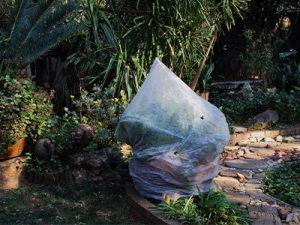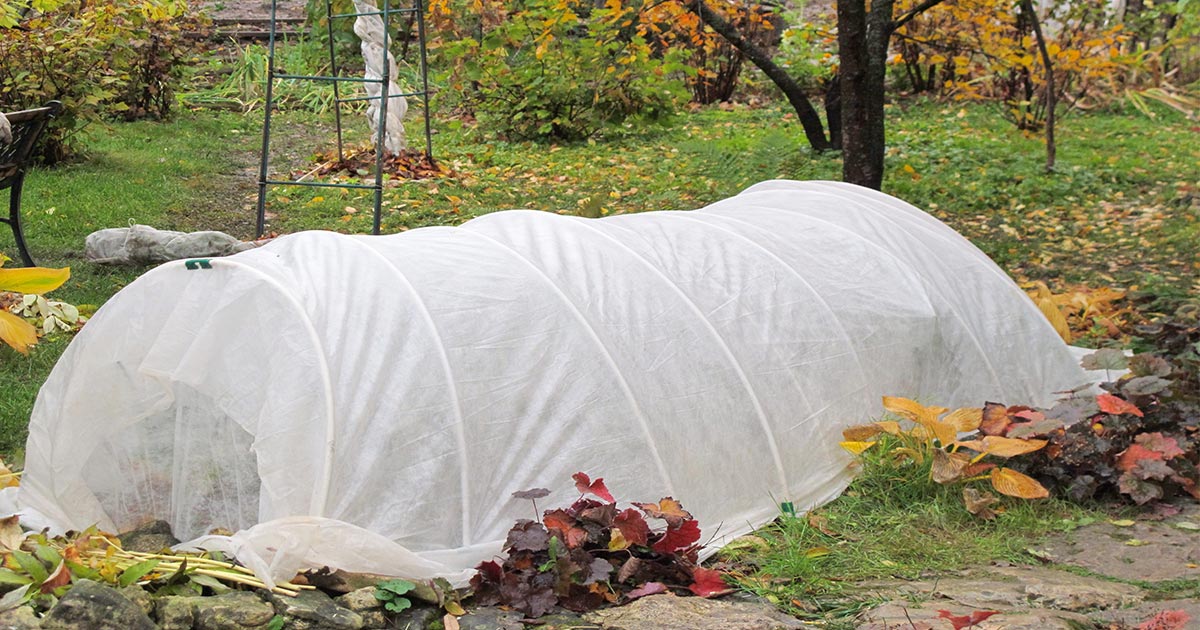In some way, plants are like pets and children. They need to be nurtured, and some have special needs.
Even though winter plant protection in Florida is less of a concern than in many other parts of the country, some seasonal preparations are recommended to assure that trees, shrubs, and landscape plants remain healthy and “happy” all year long. The University of Florida offers basic advice to gardeners, with practical information about how to prepare a Florida landscape for cold weather and possible freezes.
Plant protection for winter focuses on minimizing potential damage to plants and shrubs. Tropicals are not cold-hardy, and even though prolonged freezes are uncommon, a single night of wind and cold, with temperatures between 30 and 40 degrees, can cause lasting trauma for tender plants.
Plant Protection: First Things First
 Perhaps the best plant protection for winter in Florida is to plan a garden properly at the outset. Select plants for weather tolerance as well as beauty. Plant different types of plants in areas that meet their specific requirements for drainage, support, sun and shade, and wind protection. Group plants of different kinds to gain the advantages of symbiotic relationships. A well-designed landscape will be hardier, and more effective, in other ways as well.
Perhaps the best plant protection for winter in Florida is to plan a garden properly at the outset. Select plants for weather tolerance as well as beauty. Plant different types of plants in areas that meet their specific requirements for drainage, support, sun and shade, and wind protection. Group plants of different kinds to gain the advantages of symbiotic relationships. A well-designed landscape will be hardier, and more effective, in other ways as well.
Prepare your soil properly. Use some cold-hardy shrubs to shield more vulnerable plants. A fence on the north side of a planting area offers some protection from cold winds. Plant especially tender plants close to buildings or masonry walls, particularly on the south or east sides, where heat from the sun is retained longer. By taking advantage of these “natural” winter protection, you’ll have less to worry about when a cold snap occurs.
Maintain a regular schedule throughout the year for fertilization, pest and weed control, and watering. Plants that have been properly fertilized in the fall will better withstand cold temperatures and wind and are likely to bounce back more quickly after a freeze. Regular watering also strengthens root systems and helps eliminate plant stress to assure hardier plants.
Proper mulch helps to insulate the ground and protect plants. Finally, try to give your plants some extra water in advance of a cold front. The best time is morning, so that water can be absorbed during the day. The daytime sun will warm the soil, adding more protection for plant roots. Coupled with an external covering, your plants stand a better chance to survive and thrive.
Always cover vulnerable plants when a cold snap is expected.
How to Protect Plants in Winter
There are right and wrong ways to provide the needed coverage. Here are some tips to remember:
Specialty plant-covering material is widely available from local nurseries or landscape specialists. Good alternatives are sheets, burlap, or simple lengths of lightweight, inexpensive fabric like muslin. Try not to use heavy materials that will bend branches or compress the foliage. The best covering will be reusable. Shake it out, fold it neatly and store it so that it’s readily available to use again.
In-ground Plants and Garden Beds
- In most cases, covering should be kept loose around the plant. If possible, minimize the cover’s contact with tender leaves and delicate stems. Some type of support structure or wire cage can be helpful.
- Plant covering should extend all the way to the ground for full protection, creating an “air pocket” around the plant that traps heat inside. Anchor the covering as necessary to prevent it from blowing away or shifting position.
- When the temperature rises or the winds die down, remove the covering.
- Avoid plastic sheeting. Although plastic might seem like an easy and effective way to shield your plants, it doesn’t “breathe,” and it tends to allow moisture to form on plant leaves, causing them to burn.
Potted Plants and Container Gardens
- Extremely delicate flowering plants should, ideally, be moved indoors during a freeze. Even short-term exposure can cause leaf damage or prevent a plant from flowering. In extreme cases, cold can quickly kill a young plant.
- If the containers are too large, or if there are too many to bring indoors, it’s best to try to congregate them together as much as possible. Cover them in groups, in much the same way you would cover plants in the ground.
- Again, once temperatures rise, separate the containers as soon as possible, and return them to their original places in the garden and the rejuvenating benefits of fresh air and sunshine.
What to Do After a Winter Freeze
Winter plant protection in Florida also requires knowing how to deal with any plant damage. First, don’t immediately reach for the pruning shears, even if your plants have some damaged foliage. Don’t fertilize. Even though you might think of fertilizer as a “treat” for your plants, fertilizing encourages new growth, and the plant first needs some time to recover before it starts growing again. Don’t encourage new growth before all threat of freezing has passed.
Some leaf drop is to be expected following a freeze. Don’t worry, it’s normal. Leaves that appear wilted or those that turn partially or even completely dark are typically not a major concern; it is a sign of foliage burn, and new foliage will likely appear in the spring.
Fungus, identified by brown spots that appear on leaf surfaces, can be treated with a systemic fungicide when the cold snap is over. Some gardeners spray with fungicide in late fall as a preventive measure to increase plant resistance to fungus.
Assuring Year Round Horticulture Protection
Know that the best prepared and cared-for landscapes can suffer some damage, even during a relatively mild Florida winter. But, with minimum protection, most plants will weather the cold and return to their normal growth patterns as warmer temperatures return. Spring is the time to remove any dead or damaged limbs or branches. If you pay attention to your plants and take care of gardening needs on a regular basis, you’ll enjoy your landscape for many seasons to come
If you’re concerned about the health of your horticulture or are new to Florida, consider the benefits of professional expertise. If you’re interested in learning more about our landscape design and service options, contact us now to schedule a consultation.
ASI is a full-service landscape planning and maintenance firm with locations in both Tampa and Orlando. With 20 years of experience and a growing roster of satisfied clients, we can help you design a landscape and take the burden of its care off your shoulders. Although we can’t prevent a sudden freeze, we can help you prepare for it, and deal with the consequences.


